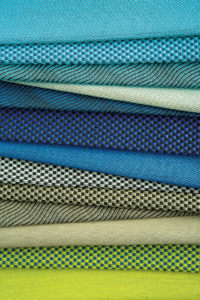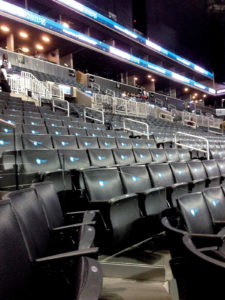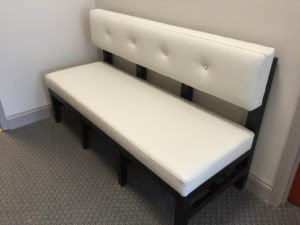
The commercial upholstery market is becoming increasingly performance oriented, with noticeable growth in health care, hospitality and sports. New fabrics and coatings are in demand, and in development.
When most people think of commercial upholstery, they think of offices . While that`s a big part of the market, it`s by no means where the most growth is taking place. The hot spots are where there`s the biggest economic boom, and where the upholstered items must be replaced or refurbished most often .
Health care fits both those descriptions. Allen Hawks, market manager, contract fabrics, at Glen Raven Custom Fabrics, Burlington, N.C., says now that the Affordable Care Act (ACA) has been in effect for a couple of years, the hubbub has settled down and spending is picking up.
The health care market doesn’t just mean hospitals, says Martin Gurian, director of engineering resources and technical education at Designtex, New York, N.Y.
“I include in health care quite a range of facilities,” he says. “Not just the hospitals, but also senior living and nursing homes, which are expanding rapidly. You have the emergency clinics, which are spreading all over the place. And you have veterinary clinics, physicians’ offices, MRI facilities. You could even put the sports medicine clinics in there. So there’s quite a large range.”
Hospitality settings are the other big growth area. Michael McMahon, project manager of operations at Furniture Concepts, Malden, Mass., says one of the things he’s seen pick up recently is common-area seating in lobbies and other hospitality areas.

The first large commercial installation of Nano-Tex-treated upholstery in a major sporting venue was the upholstered seats (18,000 of them) at the Toyota Center Houston Rockets basketball arena in 2003. The polyester fabric was treated with the cutting-edge nanotechnology-based protective stain-resistant finish; in the evaluation stage, the Rockets organization had provided a list of 30 stains of concern in their arena. Photo: Designtex
The first large commercial installation of Nano-Tex-treated upholstery in a major sporting venue was the upholstered seats (18,000 of them) at the Toyota Center Houston Rockets basketball arena in 2003. The polyester fabric was treated with the cutting-edge nanotechnology-based protective stain-resistant finish; in the evaluation stage, the Rockets organization had provided a list of 30 stains of concern in their arena. Photo: Designtex.
“We’ve done quite a few public areas in hotels, restaurants, condominium complexes and apartment complexes,” he says. “We’ve done a lot of lobbies, and some of the larger apartment complexes in Boston even have common-area libraries where we’ve done a lot of custom pieces. Where we would probably do one or two of those types of jobs a year two or three years ago, we’ve probably done eight or nine of them in just the last 18 months.”
In many cases, the hospitality work has been planned for some time, but owners have been holding off until now, McMahon says.
“Boston has a lot of older buildings with big renovation projects scheduled,” he says. “On a lot of these bigger projects with clients we’ve talked to, the plans have been there but the cash wasn’t released yet. It seems like a lot of these projects had been on the books for several years and they were just waiting for the financing to come through. I know that was the case in January of ’14—we had two really big lobbies, one in a hotel and one in an apartment building at the Prudential Center, that were both like that. Those jobs were almost $100,000 worth of furniture each.”
Some hospitality work comes from unexpected sources. Robert Burkart, owner of Sewline Upholstery in Medicine Hat, Alberta, Canada, says a local casino often needs new seating, but “they really lowball it out,” and the work goes to larger, more production line-oriented shops.
Gurian says cruise lines are a major market for his shop. They’re practically health care facilities, he says. Because there have been infection scandals in recent years, cruise lines are always interested in revamping their ships with seating that’s more cleanable and more resistant to contamination. Another source of income is sports stadiums.
“Sports arenas are one of the markets that is able to build new stadiums every 10 years, and colleges are expanding their stadiums to greater capacities for seating,” he says. “It’s not just in the United States, but worldwide—soccer stadiums, all kinds of sports. They’re constantly redoing the luxury lounges and all of the facilities, so that’s a very active area.”

Value in performance
All of these common areas present their own challenges, and upholsterers have responded by deploying increasingly technical textiles.
“When I entered Designtex 23 years ago, it was really all about who had the most beautiful fabric with the most beautiful design,” says Gurian. “Today, design is still very, very important, but the product has to perform. Customers have very high expectations on cleanability, for example. In surveys of interior designers, it’s the number one attribute they value.”
Along with cleanability and stain resistance, durability is at the top of the list. Most of the fabrics specified in the commercial environment must survive 50,000 double-rubs in testing, says Hawks.
“People want things to last,” Gurian says. “Hotels maybe change [their upholstery] every three years, but a hospital doesn’t want to change every five years. And sporting arenas have 18,000 seats, so if you don’t know what you’re doing you could be put out of business. What would happen to you if you had to replace 18,000 seats?”
But the technical requirements don’t end there, depending on the application. For example, the city of Boston adheres to California’s CAL-133 fire code rather than the more common (and less rigorous) CAL-117. And medical and international settings take flammability very seriously.
“If you deal with cubicle curtains or privacy curtains in health care, they have to pass NFPA 701,” says Gurian. “They usually have to be constructed of inherently flame-retardant polyester so they can be laundered and still be flame retardant. If you work with cruise lines, you deal with IMO, the International Maritime Organization regulations. Fabrics often have to be FR treated to meet those very rigorous demands. And if you deal with international trade, the U.K. or France or Italy or Germany, they all have very demanding fire codes.”
Resistance to disease-causing agents is one of the most valued attributes in fabrics for the health care market, but other markets are starting to value this property as well. Dow Microbial Control, Philadelphia, Pa., has been marketing its Silvadur™ technology for upholstery in these areas. Silvadur is a polymer fabric coating that releases silver ions in a controlled manner, neutralizing bacteria.
“We always get extreme interest and uptake from the medical community,” says Karel Williams, global strategic marketing associate director at Dow Microbial Control. “Even though our product is not intended to be a supplement to any type of drug or medical procedure approach in the medical setting, they like that added assurance that the fabric or upholstery is protected. The next place we get interest is typically the hotel/motel accommodation area. We’ve been focusing a lot on bedding, and in some cases carpets, rugs and wall coverings. For the hotels now that are going to upholstered dining chairs in the lobby or hospitality areas, we see quite a bit of interest.”

Environmental concerns add yet another layer of technical complication. Even in the absence of LEED standards, which send many green-minded building owners in search of sustainable materials, regulations such as California’s Proposition 65 require suppliers to certify that certain hazardous chemicals are absent. Gurian says Designtex has a full-time employee whose job is to review the thousands of SKUs associated with all the company’s products, making sure they’re free of formaldehyde, toluene and any number of other compounds. That’s a good thing, except that in many cases chemicals are what imparts the cleanability, stain resistance, durability and flame retardancy that clients seek. Working in the commercial upholstery arena is a constant tug-of-war between these battling concerns.
“A guy like me, half the time I’m looking for environmentally friendly chemicals,” says Gurian.
Future growth—and challenges
The commercial furniture market is set to continue expanding, sources say—and what’s most interesting about it is that health care environments are starting to blur with other types of commercial spaces. That means the cleanability, stain resistance and infection control that are important in health care will become more important in the overall market.
“I think you’re going to see hotels and the hospitality business continue to be built in the next five or ten years all over the world,” says Hawks. “Health care is going to be a huge growth area because of the baby boomers moving into that next phase of life. But the focus of health care is going to change from the hospital and post-treatment era that we’ve been in and will instead start focusing more on wellness. Hospitals are going to become more like trauma centers, and most routine care will move out to outreach facilities in neighborhoods and country areas. That’s going to create some nice growth opportunities for companies such as ourselves that want to participate in this market, because there’s going to be a lot of new construction going on.”
Meanwhile, however, upholsterers and their suppliers will be scrambling to keep up with ever-more-technical requirements. Gurian says there’s research going on, but it’s not necessarily aimed at commercial upholstery fabrics. It follows the money.“Big end uses like carpets or automotive are going to drive [research] because of the billions of pounds of fiber that go in there,” he says. “We’re a little peanut by comparison. Our industry is too small to develop a new fiber for upholstery. We don’t justify the investment. We have to be a by-product. We often benefit from something that was developed for another large market.”
The requirements for these fabrics will get more rigorous over time, predicts McMahon. “It just seems like more and more towns are requiring some type of fire code certification, where maybe in the past it was just the bigger cities,” he says. “More and more of the work we do now in the surrounding suburbs, they require some sort of testing or they want to see some sort of certification that it meets some sort of code, whereas before it was almost like a free-for-all.”
New fiber and fabric research can’t come a moment too soon, says Gurian, because technical requirements will continue to be the number one driver in the industry.
“You have a catch-22 situation,” he says. “You have customer expectations that are very high already because of all the high-performance materials that are in use and are doing very well. Then you have the environmental pressures, where clients are asking for things that don’t even exist yet. They want things to meet building codes; they want things not to have VOCs or off-gassing; they want to have fabrics that look like they’re brand new without cleaning them. You can’t use flame retardants in certain cases, yet you’ve got to meet building codes. That’s a big dilemma for an industry that doesn’t have textile engineers and chemists sitting in white coats. We’ll either have to have some new breakthroughs or we’ll start to be limited design-wise by these restrictions.”
Jamie Swedberg is a writer and editor based in Woodville, Ga.
Digital printing for commercial upholstery?
Digital printing is a major growth area in commercial fabrics, offering unprecedented design freedom, unlimited colors, wide repeats or landscapes and bright high-tech inks. But while it’s ubiquitous in advertising, events and retail, digitally printed fabric hasn’t made much of a splash in the commercial upholstery market. Martin Gurian, director of engineering resources and technical education at Designtex, New York, N.Y., explains that the use of digitally printed fabric in commercial upholstery is still in its infancy because of the technical requirements that have become important in these applications.
“You’ve got to be able to protect the printing inks,” he explains. “If they’re just used without any protection, and you start to use strong disinfectants or strong cleaning agents or bleach, you could destroy the fabric. And then you have flammability regulations: if you’re doing wall coverings in a commercial building, you have to meet ASTM E84. That’s not easy when you start to put inks and chemicals on top of a fabric. Even if a fabric alone passes a test, when you start adding other things, you could get smoke or other concerns.”
For these reasons, Gurian says, commercial upholsterers may hesitate to use digitally printed fabric in a health care or hospitality environment, because they won’t necessarily be able to warranty it.
Then there’s the issue of replaceability, says Michael McMahon, project manager of operations at Furniture Concepts Inc., Malden, Mass. Anything upholstered in digitally printed fabric will have to be re-covered in it, too, and that could greatly increase the turnaround time.
“In a restaurant setting, things get ripped all the time,” he says. “Well, if you can’t find the fabric to match it, you can’t reupholster it. So most of the time, when we do work, we use something that’s produced enough that they’re able to get repeats of it.”
“Digitally printed designs are gorgeous, and there’s no question that the designers get excited with the capabilities,” Gurian says. “The question is, can we engineer them so that they can perform in commercial environments? These are potentially growth areas, depending on the ability to engineer these products to perform in these markets. That’s the tricky part.”

A clean "pop"
Commercial upholstery design right now isn’t about a particular color family or a particular shape. It’s about definition and “pop.”
Seating can take practically any form as long as the lines are clean. The same design trends that are shaping residential furniture have taken over commercial spaces as well, says Jon Weingarten, president of Dazian LLC, New York, N.Y.
“What I’m seeing is the revival of 1960s retro designs of both curved and modular furniture, with clean, basic fabrics with stretch,” he says.
Allen Hawks, market manager, contract fabrics, at Glen Raven Custom Fabrics, Burlington, N.C., says the most important design attribute is clarity of color and detail in design. “They want a very clean, clear definition on the patterns; for the outer edge of the patterns, they like them to be clean and crisp,” he says. “And pure color is very important to that group, too.”
But texture is where commercial upholstery parts ways with residential trends. Residential work is all about plush, soft fabrics right now, and some higher-end commercial environments are following suit. But most commercial sites value technical characteristics such as cleanability far more than texture, so they tend to stick with styles where lower-pile fabrics will be a better match.
“I think softness, overall, is important,” says Hawks. “But being really plushy is not as important, because it doesn’t clean well.”

Feeling the squeeze
Robert Burkart, owner of Sewline Upholstery Ltd., Medicine Hat, Alberta, Canada, says one of the biggest problems with commercial upholstery jobs is the strain they put on staffing. With only five shop employees and ongoing difficulties finding skilled laborers, he’s stretched to the limit. For a large job, he sometimes has to call ex-staffers out of retirement.
Another issue is profit margins. Sewline doesn’t have the staff to build frames, so it contracts that work out. And corporate designers will often pick out and purchase their own fabric. The small shop doesn’t have to worry about technical specs, but the downside is that there’s only labor and foam to charge for, which doesn’t make very much money per item.
“We’re looking at a restaurant now that’s doing a renovation, and they want to move two booths from the lounge over into the restaurant,” says Burkart. “Well, I have to get my contractor to do that, over and above my price. And then they want to supply materials. That takes away any kind of profits on our jobs.”
But there’s a bright side, too. Smaller, more locally based businesses can take on work that larger shops can’t or won’t do. And they thrive on diverse jobs and eclectic small-scale projects.
“We do furniture, we do cars, we do boats, we do aircraft, we do awnings,” says Larry Schneider, owner, president and CEO of Homestyle Awning & Upholstery, Bay View, Wis. “We just did all the seats for the high-speed ferry that goes out of Milwaukee to Michigan. Right now we’re doing 25 cushions for a guy who invented a foot massager that takes money for airports and hotels.”
Another plus: small shops are often well-placed to offer repairs and long-term care. According to Michael McMahon, project manager of operations at the 15-person shop Furniture Concepts Inc., Malden, Mass., “When we make restaurant booths, we make it so that our seats are removable. If the restaurant is local, we’re able to go into the city in the morning, pick up two or three damaged seats, bring them back to our shop, reupholster them, and bring them back before they even start serving lunch.”
 TEXTILES.ORG
TEXTILES.ORG


